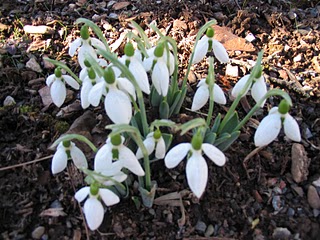One of the most popular flowers grown in greenhouses in The Impatiens. Known lovingly as "Busy Lizzie's", these plants make up a huge proportion of the flowers grown in greenhouses for retail sale in spring.
Imagine being a grower that depends on this flower to make ends meet, and you find out that a new disease is threatening your crop. The disease, Plasmopara obducens, is also known as "Impatiens downy mildew". In 2011 the disease was confirmed in coastal southern California, northeast Illinois, northern Indiana, the Twin Cities region of Minnesota, Cape Cod, Massachusetts, Long Island, and upstate New York. If you’re in those regions, keep an eye out for the disease. Green Profit, a trade magazine tells us what growers will be looking for in the greenhouses.
"• Lightly chlorotic or stippled leaves. Subtle gray markings may also appear on the upper leaf surface.
• Leaves may turn downward from the leaf margins.
• A white, downy growth may be present on the underside of affected leaves. "
This disease is so serious that Thompson & Morgan, a larger seed company won't even be offering Impatiens this year. According to their website, "Thompson & Morgan has decided to drop all walleriana types (as this is the only strain that succumbs to the mildew) from the range. With sales in excess of £1,000,000 it would have been an all too easy for us to carry on offering our best selling bedding plant, but we want our customers to be completely satisfied."
This disease only affects the "Walleriana" type of Impatiens. "New Guinea" impatiens are highly tolerant of the disease and should not be confused with the "Walleriana" (Busy Lizzie) types. A big issue with this disease is it often does not manifest itself in the greenhouse, but later in the customers garden. A lot like the Late Blight of Tomatoes that occurred in 2009.
Green Profit has this advice for anyone thinking of selling Impatiens at their garden center this year. "The phrase 'What they don’t know can’t hurt ’em' is not applicable here. In fact, it could end up hurting you. Customers who find impatiens downy mildew on their plants after purchase—whether it’s in baskets or beds—will likely assume your business is at fault. 'What, me go back to Joe’s Greenhouses? They sold me those bum impatiens.' Not what you want happening." Here is what garden centers should do for their customers according to Green Profit,
"Inform the customer of:
• the disease’s existence, especially if the disease has been verified in or near your region.
• the symptoms (leaf yellowing and premature leaf and flower drop) to watch for.
• that although plants may be healthy when they leave the garden center, they could become infected once planted into the landscape, with the risk of susceptibility being higher in beds with a previous history of the disease.
• its higher incidence of occurring in locations that are heavily shaded, densely planted and stay moist for long times.
• planting measures that could lower the likelihood of the impatiens downy mildew—and diseases, in general. "
If you live in one of the affected areas check out your local garden center, and see what advice they are or will be offering this spring. Garden centers that have worked hard to build trust with their customers will be honest and forthright, explaining the issue and possible solutions. It will be interesting to see how garden centers, growers, and the individual gardener respond to this issue come spring, and summer.



